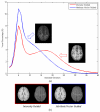Attribute vector guided groupwise registration
- PMID: 20097291
- PMCID: PMC2839051
- DOI: 10.1016/j.neuroimage.2010.01.040
Attribute vector guided groupwise registration
Abstract
Groupwise registration has been recently introduced to simultaneously register a group of images by avoiding the selection of a particular template. To achieve this, several methods have been proposed to take advantage of information-theoretic entropy measures based on image intensity. However, simplistic utilization of voxelwise image intensity is not sufficient to establish reliable correspondences, since it lacks important contextual information. Therefore, we explore the notion of attribute vector as the voxel signature, instead of image intensity, to guide the correspondence detection in groupwise registration. In particular, for each voxel, the attribute vector is computed from its multi-scale neighborhoods, in order to capture the geometric information at different scales. The probability density function (PDF) of each element in the attribute vector is then estimated from the local neighborhood, providing a statistical summary of the underlying anatomical structure in that local pattern. Eventually, with the help of Jensen-Shannon (JS) divergence, a group of subjects can be aligned simultaneously by minimizing the sum of JS divergences across the image domain and all attributes. We have employed our groupwise registration algorithm on both real (NIREP NA0 data set) and simulated data (12 pairs of normal control and simulated atrophic data set). The experimental results demonstrate that our method yields better registration accuracy, compared with a popular groupwise registration method.
2010 Elsevier Inc. All rights reserved.
Figures










Similar articles
-
Attribute vector guided groupwise registration.Med Image Comput Comput Assist Interv. 2009;12(Pt 1):656-63. doi: 10.1007/978-3-642-04268-3_81. Med Image Comput Comput Assist Interv. 2009. PMID: 20426044
-
Feature-based groupwise registration by hierarchical anatomical correspondence detection.Hum Brain Mapp. 2012 Feb;33(2):253-71. doi: 10.1002/hbm.21209. Epub 2011 Mar 9. Hum Brain Mapp. 2012. PMID: 21391266 Free PMC article.
-
Groupwise registration by hierarchical anatomical correspondence detection.Med Image Comput Comput Assist Interv. 2010;13(Pt 2):684-91. doi: 10.1007/978-3-642-15745-5_84. Med Image Comput Comput Assist Interv. 2010. PMID: 20879375 Free PMC article.
-
SharpMean: groupwise registration guided by sharp mean image and tree-based registration.Neuroimage. 2011 Jun 15;56(4):1968-81. doi: 10.1016/j.neuroimage.2011.03.050. Epub 2011 Apr 2. Neuroimage. 2011. PMID: 21440646 Free PMC article.
-
Groupwise registration based on hierarchical image clustering and atlas synthesis.Hum Brain Mapp. 2010 Aug;31(8):1128-40. doi: 10.1002/hbm.20923. Hum Brain Mapp. 2010. PMID: 20063349 Free PMC article.
Cited by
-
PopTract: population-based tractography.IEEE Trans Med Imaging. 2011 Oct;30(10):1829-40. doi: 10.1109/TMI.2011.2154385. Epub 2011 May 12. IEEE Trans Med Imaging. 2011. PMID: 21571607 Free PMC article.
-
An artificial-intelligence-based age-specific template construction framework for brain structural analysis using magnetic resonance images.Hum Brain Mapp. 2023 Feb 15;44(3):861-875. doi: 10.1002/hbm.26126. Epub 2022 Oct 21. Hum Brain Mapp. 2023. PMID: 36269199 Free PMC article.
-
S-HAMMER: hierarchical attribute-guided, symmetric diffeomorphic registration for MR brain images.Hum Brain Mapp. 2014 Mar;35(3):1044-60. doi: 10.1002/hbm.22233. Epub 2013 Jan 2. Hum Brain Mapp. 2014. PMID: 23283836 Free PMC article.
-
Fast Groupwise Registration Using Multi-Level and Multi-Resolution Graph Shrinkage.Sci Rep. 2019 Sep 3;9(1):12703. doi: 10.1038/s41598-019-48491-9. Sci Rep. 2019. PMID: 31481695 Free PMC article.
-
Registration of challenging pre-clinical brain images.J Neurosci Methods. 2013 May 30;216(1):62-77. doi: 10.1016/j.jneumeth.2013.03.015. Epub 2013 Apr 1. J Neurosci Methods. 2013. PMID: 23558335 Free PMC article.
References
-
- Balci SK, Golland P, Wells W. Non-rigid Groupwise Registration using B-Spline Deformation Model. Open Source and Open Data for MICCAI. 2007:105–121.
-
- Baloch S, Verma R, Davatzikos C. An Anatomical Equivalence Class Based Joint Transformation-Residual Descriptor for Morphological Analysis. Information Processing in Medical Imaging. 2007:594–606. - PubMed
-
- Beg MF, Miller MI, Trouvé A, Younes L. Computing Large Deformation Metric Mappings via Geodesic Flows of Diffeomorphisms. International Journal of Computer Vision. 2005;61:139–157.
-
- Christensen G, Geng X, Kuhl J, Bruss J, Grabowski T, Pirwani I, Vannier M, Allen J, Damasio H. Introduction to the Non-rigid Image Registration Evaluation Project (NIREP) Biomedical Image Registration. 2006:128–135.
Publication types
MeSH terms
Grants and funding
LinkOut - more resources
Full Text Sources

